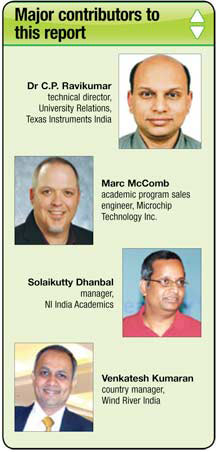As compared to the existing government or public sector players, the private sector is always ready to offer more lofty figures for candidates with suitable exposure. The ability to multi-task may be a defining factor here.
Kumaran mentions, “Though I cannot comment on the exact numbers, the embedded sector is a high-paying field offering salaries roughly twice that of engineers in the enterprise field.”
The future is embedded
Let’s see what’s in store for embedded devices in future. “Everything is going to be connected and all electronics will be pretty interoperable. Everything you touch in your home like TV, refrigerator, PC and phone is going to get connected to an extent that you will be able to remotely manage electronic devices from any location. For instance, if you want to know how much milk is left in your refrigerator, you will be able to look it up through your phone. The device will actually send you an alert when the quantity goes down and then also remind you to make a purchase order,” says Kumaran.
connected and all electronics will be pretty interoperable. Everything you touch in your home like TV, refrigerator, PC and phone is going to get connected to an extent that you will be able to remotely manage electronic devices from any location. For instance, if you want to know how much milk is left in your refrigerator, you will be able to look it up through your phone. The device will actually send you an alert when the quantity goes down and then also remind you to make a purchase order,” says Kumaran.
In the near future, Dhanbal says, “There will be a proliferation of open tools and architecture both at the hardware and software systems level. The tools will provide for programming functionality to the pin.”
McComb expects development platforms to become easier to use in order to help engage new users from non-traditional embedded markets. “This can be seen today with the increasing popularity of development tools with graphical programming environments, or very high-level programming languages with easy-to-use, expandable hardware components. Such tools have opened the embedded world to new users such as artists, hobbyists, high-school students, and more,” he elaborates.
Handy tips
Now that you have got enough boosters from the ‘opportunities to be grabbed’ in this field, it’s also important to understand what the embedded industry expects from an individual. As experts point out that the actual hands-on experience is indispensable, your bookish knowledge might not be adequate to catch the speed of an industry which is experiencing the great technological revolution.
“Microchip looks for certain skills on a case-by-case basis, for a particular focus. For example, some applications are more software-centric, such as our touch-sensing technologies. In this case, a priority could be placed on a candidate’s abilities to create efficient and effective firmware, while still being able to understand how their software will interact with the rest of the system,” McComb states.
He continues, “Our company has solutions for many different industries such as medical, appliance, automotive, and more. Therefore it’s hard to generalise what skills will be valued in a candidate.”
Wind River primarily recruits for the post of technical account manager. For this role, the company looks for people “who have worked in the software field for more than five years and are now looking to move to an area of field application. The job requires engineers to have deep understanding of technologies,” states Kumaran.
Presently, National Instruments (NI) does not hire people for embedded systems. However, Dhanbal informs, “When we do we will look forward to professionals with broad-based knowledge of tools.”
The fields of electronics and computer science have become more challenging and interesting in the last decade. Dr C.P. Ravikumar, technical director, university relations, Texas Instruments (TI) India, suggests, “Embedded systems have evolved as a major discipline, encompassing many technologies such as sensors, analogue, embedded processors and embedded software. At the same time, educational resources have become available at lower costs. Today, you can find free online educational content, free software tools and low-cost hardware tools. Students must take advantage of these opportunities with the help of a mentor.”
So dig out all the possibilities to get a practical exposure and make sure the fundamentals are clear. Finally, your future is in your hands.
The author is from EFY Bureau, New Delhi






